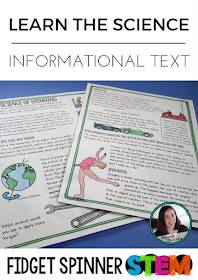Fidget Spinners Driving you Crazy?
The whir might have faded to background noise to you at this point, or maybe you can't get it out of your head. Before you ban fidget spinners completely, why not put a spin on the fidget fad and engage your students in a STEM challenge?Disclaimer: I may earn a small commission for my endorsement, recommendation, testimonial, and/or link to any products or services from this website. Your purchase helps support my work in bringing you downloads of value and information about educational resources. The link below is an Amazon affiliate link. You can read my full disclosure here.
 |
| Fidget Spinner STEM Challenge |
Turn that Obsession into a Learning Opportunity
Start off by learning the science of rotational motion. I have provided informational text about inertia, angular velocity, torque, and more so that students first get an understanding of the spinners from a scientific perspective. This is reinforced with hands-on experiments and demonstrations, such as noting how the center of mass will change based on where weights are placed on an object.
Follow the Engineering Design Process
The engineering design process (EDP) is the method engineers use to solve problems. It has some similarities to the Scientific Method so if you haven't used the EDP before, read through the steps:ASK - What is the problem? Has it been solved before?
IMAGINE - Some solutions to the problem. How large will your spinner be? How many arms will it have? What materials are available to use? Do you have design constraints?
PLAN - Sketch your design and label it.
CREATE - Build the design and then test it. How long does it spin? Does it fit comfortably in the hand to spin it? Is it assembled well and symmetric? Record and analyze the data.
IMPROVE - Can you make it spin more smoothly or for longer? What might be causing friction?
SHARE & REFLECT - Share your design with someone else. What do they think of it? Could their feedback help you improve the spinner even more?
Math Extension Activity
How much would it cost to make 1000 spinners? Students create a Bill of Materials (BOM), calculate the cost to assemble the spinner, and find the volume to calculate the cost of the packaging. Why is this important? Engineers need to be mindful of costs when creating a new product. What if the cost of the raw material goes up? How can you cut costs in a different way. Packaging design is a whole branch of engineering - think about all the different packages you encounter in goods you purchase. An engineer was involved in the design of that package, cost was a very important factor in the package design.
Get Creative with Marketing and Graphic Design
Students need to think about who might buy their spinner and then create a marketing campaign to hook potential buyers! They can also create a fun design on a traditional spinner to catch a shopper's eye. Why is this step important? You can have the best product in the world, but if nobody knows about it, it won't sell and ultimately will fail in the market.Why STEM?
Not only do students work in small teams, which helps foster community and teamwork, but they also learn to fail and embrace a growth mindset. You will see amazing problem-solving and creative thinking with this project. Students use higher-order thinking skills in their STEM projects, and they can use those skills in other academic areas as well. Because there are so many possible solutions to this problem, there are many avenues to success. You may even inspire a student to come up with a new and unique spinner that is better than commercially available ones!Find it on TpT
The full resource can be found on Teachers pay Teachers. It includes everything shown here and more. There are samples, teacher notes, and planning pages to help you make this a successful challenge in your classroom or at home. If you are looking for some tips and tricks to try this on your own, though, read on for a video.Easy Shopping Links
Amazon affiliate links:Neodymium Magnets or here
Skate Bearings
Gorilla Tape
Tin of Marbles or here







No comments:
Post a Comment